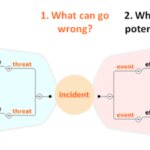Quick guide to Risk Analysis:
Step 1: The first step (covered in the previous lecture) is to define the context and criteria.
Step 2: Identify the system boundaries, these boundaries will dictate the extent of responsibility.
Step 3: Identify potential hazards in that system.
Step 4: Quantify the risks: calculate the probability of hazardous outcomes, and their impact.
Step 5: Anticipate risk scenarios. What are the actions/events that are most likely to precipitate hazardous outcomes.
Step 6: Assess the risks, using for example risk matrices.
Step 7: Implement safeguards and stopgaps to prevent or mitigate these hazards.
Step 8: Risk assessment is never complete, always ongoing. Monitor the system vigilantly, adding or modifying measures if need be.
In accordance with this flow, some techniques that are routinely used include Fault Tree Analysis for constructing quantitative probability trees for hazardous outcomes, the Bow-Tie model for a diagrammatic representation of the causes and consequences of hazards, and risk matrices for quick action heuristics. All these and more will be detailed in the lecture.


